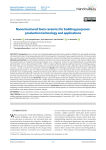Application of nanomaterials and nanotechnologies in building. Рубрика в журнале - Nanotechnologies in Construction: A Scientific Internet-Journal

Nanostructured foam ceramics for building purposes: production technology and applications
Статья научная
Introduction. Foam-ceramic heat-insulating building materials have the greatest stability of the demanded technological characteristics due to their unique physical and technical properties. Increasing the large-capacity production of nanostructured foam-ceramic products and developing educational programs for advanced training of process engineers remains an urgent task. Methods and materials. A technological method for manufacturing nanostructured foam ceramics is the method of direct foaming: ceramic foams are created by involving atmospheric air in a suspension. Further, the consolidated foams are carefully dried and sintered for 12 hours by heat treatment (950–1100оC) to obtain sufficiently high-strength foam ceramics for building purposes. The most important raw materials for the production of construction foam ceramics are clays, diatomites, siliceous minerals, zeolite rocks, etc., as well as ceramic and slag waste, and the like. Results. The technology of production of foam-ceramic materials for building purposes based on clay raw materials has been developed. As a result of physical and chemical transformations in the production cycle, including firing, uniformly closed micropores of foam ceramics with a diameter of up to 120 microns are formed, and the wall thickness varies from 1.8 microns to 6.3 microns. The compressive strength of the obtained nanostructured construction foam-ceramic products with an average density of 450–850 kg/m3 is 3–8 MPa, thermal conductivity is 0.12–0.15 W / (m●оC), frost resistance is at least 50 cycles. Discussion. In large-scale technological production, bubbles mass (three-phase foam) can be obtained by mixing nanostructured foam with a highly dispersed mineral powder. By controlled sintering, a dried foam mass is produced with the required technological characteristics due to the crystal bond of a solid-phase mullite based on cluster microparticles with dimensions of 15–200 nm, and the walls of micropores and nodal joints of nanostructured foam ceramics provide high mechanical strength, hydrophobicity and chemical resistance. Conclusions. Nanostructured foam ceramics for building purposes is sufficiently moisture-resistant, since it has a microstructure of closed ultramicropores; it is resistant to chemical and physical effects and therefore is the optimal thermal insulation material.
Бесплатно

